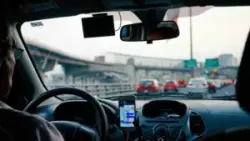
Despite lockdowns and quarantines during the COVID-19 Pandemic, America’s roads have gotten more dangerous, according to studies. According to the National Safety Council (NSC), more than 700 people are hurt in distracted driving cases on a typical day. Every year April is designated as “Distracted Awareness Month.” This awareness campaign is aimed at getting the public to stay safe by focusing on the road and just driving without distractions.
Distracted Driving
Distracted driving, according to research, is anything that takes a driver’s attention away from the task of being safe while behind the wheel. Not surprisingly, distracted drivers pose a danger to themselves and others on the road. Each day approximately eight people are killed in the United States in car accidents involving a distracted driver, according to the Centers for Disease Control (CDC). The National Highway Traffic Safety Administration (NHTSA) found that as many as 3,142 people were killed in distracted driving accidents in 2019, an increase of 10% over the prior year. The CDC reports that there are three general types of distractions affecting America’s drivers — visual, manual, and cognitive.
A visual distraction includes anything that takes a driver’s eyes off the road such as:
- Looking out the window while driving during a scenic route and not the roadway;
- Adjusting the radio station on the car’s stereo;
- Using a mirror to check or apply makeup while driving;
- Looking at a traffic accident outside the car window instead of the road;
- Looking at or using a phone while driving;
A manual distraction can be anything that takes a driver’s hands off of the wheel such as:
- Eating or drinking while driving;
- Touching buttons or dials to control the car’s music, temperature, windows, or mirrors;
- A driver using their hands to assist a pet or child;
- Touching a phone while driving.
A cognitive distraction is anything that takes a driver’s mind off of the important task of actually driving including:
- Speaking with other passengers in the vehicle;
- Driving while angry or upset;
- Speaking on the phone while driving; or
- Getting lost in thought or daydreaming while behind the wheel.
Cell Phone Laws
Perhaps the most dangerous task to do while driving is texting because this distraction falls into all three categories — visual, manual, and cognitive. Texting while driving is extremely dangerous and sometimes deadly. Studies show that reading or sending a text message takes a driver’s eyes off the road for about five seconds, which equates driving the entire length of a football field with your eyes closed if the vehicle is going 55 MPH.
As a result of the rising danger of texting while driving, many states across the nation have passed laws prohibiting the use of cell phones and texting while driving. 24 states have passed laws banning hand-held phone conversations by all drivers since 2001. All 48 states ban texting while driving, and 39 states have restricted cell phone use by young drivers.
Nevada Accident Attorneys
If you are driving in Nevada, know that state law prohibits the use of cell phones or other electronic devices. If you or someone you know has been hurt in Nevada in a car accident due to the fault of a distracted driver, contact the skilled personal injury attorneys at H&P Law. We will fight for the best compensation available to you under the law.




